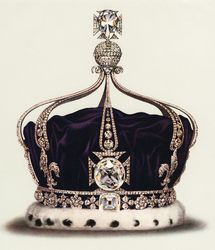Our beloved ice-cube, the Koh-i-noor, is back in public conversation this week, this time across the world. The Buckingham Palace has announced that Queen Mary’s Crown―which Queen Consort Camilla would be wearing on the coronation of King Charles III on May 6―is being reset with Queen Elizabeth’s other personal jewels, instead of the mega diamond.
The Koh-i-noor has been among the most contentious pieces of jewellery in the world. India’s cultural czars have always laid claim to it and for the last couple of decades, have asked for its return. With the growing sentiment of returning stolen artefacts by colonial museums and treasuries, especially by the UK and its encyclopedic British Museum, a gnawing subversion of history is taking place.
The Palace is certainly in damage control mode after Harry and Meghan’s Netflix documentary and the former prince’s juicy tell-all book. Perhaps Charles and Camilla also plan to be more modern and less ostentatious royals. At least that is the idea they are hoping the Palace’s PR machinery is advocating. Even Catherine, Princess of Wales, has become such a champion of the sustainable fashion trend of repeating clothes (she recently re-wore a slinky white Alexander McQueen to an event last week). The Palace note suggests the giant stone, currently at 105 carats, is being retired “in the interests of sustainability and efficiency”.
However, the coronation is being planned since a year ago, suggesting what a grand spectacle it is going to be. Perhaps, the royals expect its millions of television spectators to miss the woods for the trees, and applaud the dismissal of the contentious diamond from the much publicised event.
Or, as jewellery historian and museum archivist Deepthi Sasidharan tells me, “It is not like they are giving up any of their real estate, their prized palaces, as yet.”
The repatriation of the troubled Koh-i-noor has been ongoing for too long, and across parties. A BJP spokesperson recently demanded its return. It is perhaps the one unifying factor between the liberals and the right-wingers. That said, author and historian William Dalrymple opines that the Koh-i-noor belongs to India as much as it belongs to Afghanistan, Pakistan (it was last owned by Ranjit Singh of Lahore) and Persia (Iran). The Taliban has thrown its hat in the ring, too, asking for its return to Afghanistan.
The Koh-i-noor is indeed a magical thing. Its lure overrides all the jewels that have been looted by the British or gifted to them as truce. The dazzler has overshadowed the iconic parure of a tiara and necklace gifted by Asaf Jah VII, the Nizam of Hyderabad, as a wedding present to the queen in 1947. He had commissioned Cartier to let the queen pick her preferred jewellery from their collection. The platinum necklace comprised 300 stones.
Then there is the prized Delhi Durbar necklace, too, featuring nine large emeralds and an 8.8 carat diamond cut from the Cullinan diamond, the largest ever found diamond, which the Queen Mother wore in 1911. There are four or five other key jewels from the Golconda rulers.
The separation of the Koh-i-noor is still immensely significant to modern history. The diamond, long seen as a symbol of conquest, now brings back painful memories of a bloody colonial history. Diamonds and precious stones have long been signifiers of political clout―taking it from the colonised was a mark of pride.
Perhaps removing it from its 86-year-old setting is the first step towards its return?
@namratazakaria


